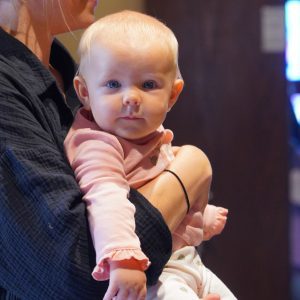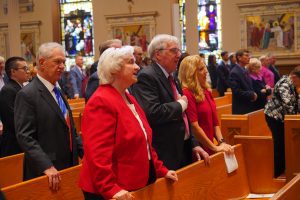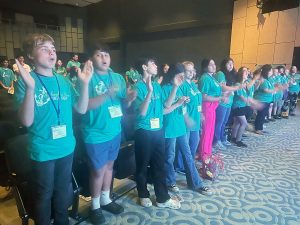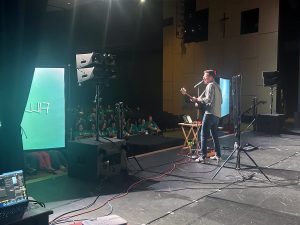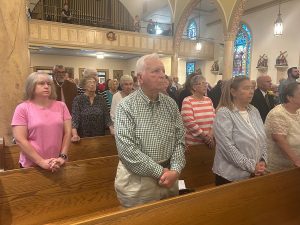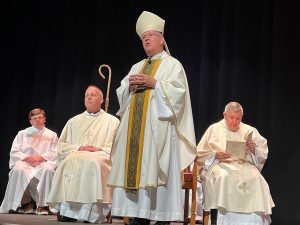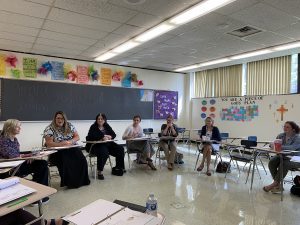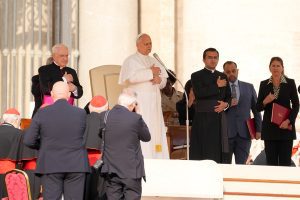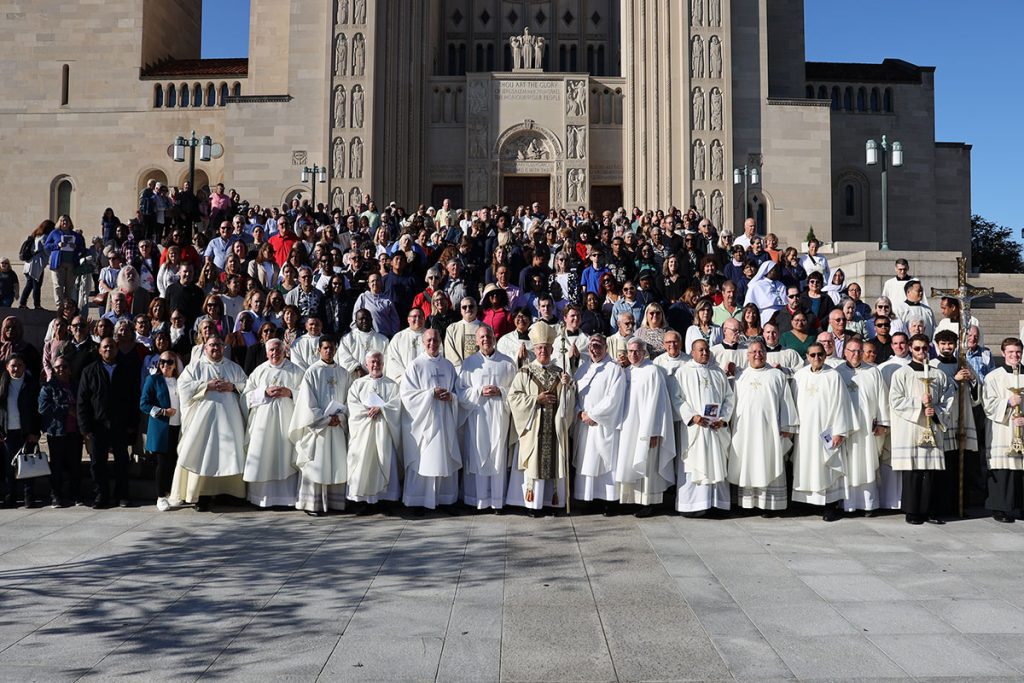
WASHINGTON, D.C. – On Wednesday, Oct. 1, 2025, more than 600 pilgrims from the Diocese of Scranton made a sacred journey to the Basilica of the National Shrine of the Immaculate Conception in Washington, D.C. as part of a Jubilee Year of Hope pilgrimage.
The pilgrimage brought together faithful from all corners of the Diocese’s 11 counties. Twelve buses carried groups from dozens of parishes – ten departing early that morning and two others arriving from overnight trips. Many others traveled by car, all drawn together by a desire to be together in faith, fellowship, and prayer.
The National Shrine – reverently called “Mary’s House” – is the largest Catholic church in North America and among the ten largest in the world.
With more than 80 chapels and oratories honoring the Blessed Virgin Mary under various titles, the National Shrine reflects not only the cultural diversity of the United States but the universality of the Catholic Church.
Upon arrival, pilgrims were welcomed by Rev. Monsignor Vito A. Buonanno, Director of Pilgrimages for the Shrine, who urged the faithful to allow Mary to be their model and guide for the day.
“From the moment you enter this magnificent edifice, the sign of the Blessed Mother is present,” he explained.
Pilgrims spent the late morning and early afternoon touring the Basilica, praying at its chapels, and taking part in the Sacrament of Reconciliation. At 2:00 p.m., Diocesan pilgrims gathered for a Eucharistic Holy Hour with the Rosary, followed by a Pontifical Mass celebrated by the Most Rev. Joseph C. Bambera, Bishop of Scranton, in the Upper Church.
‘WE MOVE FORWARD WITH HOPE’
In his homily for the Pilgrimage, Bishop Bambera called pilgrims to deepen their trust in God’s promises – especially through the example of the Blessed Mother.
“What a blessed day this has been as we’ve journeyed here, to Mary’s house, in celebration of the great Jubilee Year of Hope. I’m grateful to be with all of you on this pilgrimage,” Bishop Bambera began by saying.

Quoting Pope Francis and Pope Leo XIV, Bishop Bambera reminded the faithful that Christian hope is not naïve optimism, but a living trust in God’s love – a hope that “does not disappoint.” He drew from Saint Paul’s Letter to the Romans, proclaiming that “our hope rests solely upon God’s saving action realized in his Son, Jesus Christ.”
Preaching both in English and Spanish, the Bishop turned often to Mary’s example as the “threshold of hope.”
In a world “fraught with suffering and pain,” Bishop Bambera said, it is Mary’s posture of trust and openness that shows each believer how to live in hope.
“Her willingness to say ‘yes’ to God’s plan to bring salvation to his people is rooted in a faith so strong that it establishes the parameters for authentic discipleship down through the ages, even to our own,” he said.
Looking out at all of the pilgrims, the Bishop invited each one to find their place in God’s plan of hope – whether they are young people jugging life and faith, parents forming their children, the elderly, immigrants, or those burdened by regret.
“God uses us as we are,” he said, “when we open our hearts to him and trust.”
As he concluded, the Bishop urged pilgrims to move forward with hope, “knowing that God is with us all our days, even until the end of the age.”
PILGRIMS SHARE THEIR JOY
As he toured the Basilica, Edward Facciani of Saint John Vianney Parish in Montdale reflected on the beauty and theological richness of the side chapels.
“They give us a wonderful historical opportunity to view our whole salvific history. I found that really striking,” he said. “And, of course, the Crypt is magnificent. I really love spending time down there.”
His wife and first-time visitor Bernice Facciani felt personally called to come on the pilgrimage.
“The Lord has been trying to teach me a little bit more about Mary and when I heard that the Diocese was coming here, I thought it was a place I needed to come,” Bernice stated.
Bernice found herself thinking about all of the people who built the Basilica out of love for the Lord.
“It’s a gift that they gave to the rest of us,” she said, adding, “You could spend three days here and still not see everything there is to see in the Basilica itself.”
Karen Bernavage of Saint Catherine of Siena Parish in Moscow was also overwhelmed by the beauty of everything she took in during her tour.
“The amount of statues, the prayers on the wall. Everything about it, it just goes on and on,” she stated. “It gives you a feeling of warmth.”
Bernavage said she was happy she toured the Basilica as part of a large group.
“When everybody comes together, it makes it like a family because you’ve all experienced it together,” she added.
‘LET HOPE SPREAD’
Monsignor Walter R. Rossi, Rector of the Basilica and a priest of the Diocese of Scranton, expressed his joy at welcoming the faithful to Washington, D.C.
He noted that the Diocese of Scranton has made pilgrimages to the Basilica since 1973.
“For the past five decades, the Diocese has continued to make pilgrimages to Mary’s Shrine, especially during significant moments in the life of the Diocesan Church as well as the Church universal, as you are today, in celebration of the Jubilee Year of Hope,” he noted.
“I am thrilled that we have over 20 priests joining us this day,” Monsignor Rossi added. “Through the intercession of Mary, may the power of love fill your life this day and all days.”
After taking a group photo on the steps of the Basilica, pilgrims boarded their buses to return home.
Bishop Bambera hopes their pilgrimage serves as a powerful reminder that the Church is alive – and united – in hope.
“Let us now be drawn to this great hope,” the Bishop said, echoing Pope Leo’s Jubilee message. “And through our witness, may hope spread to all those who anxiously seek it.”

